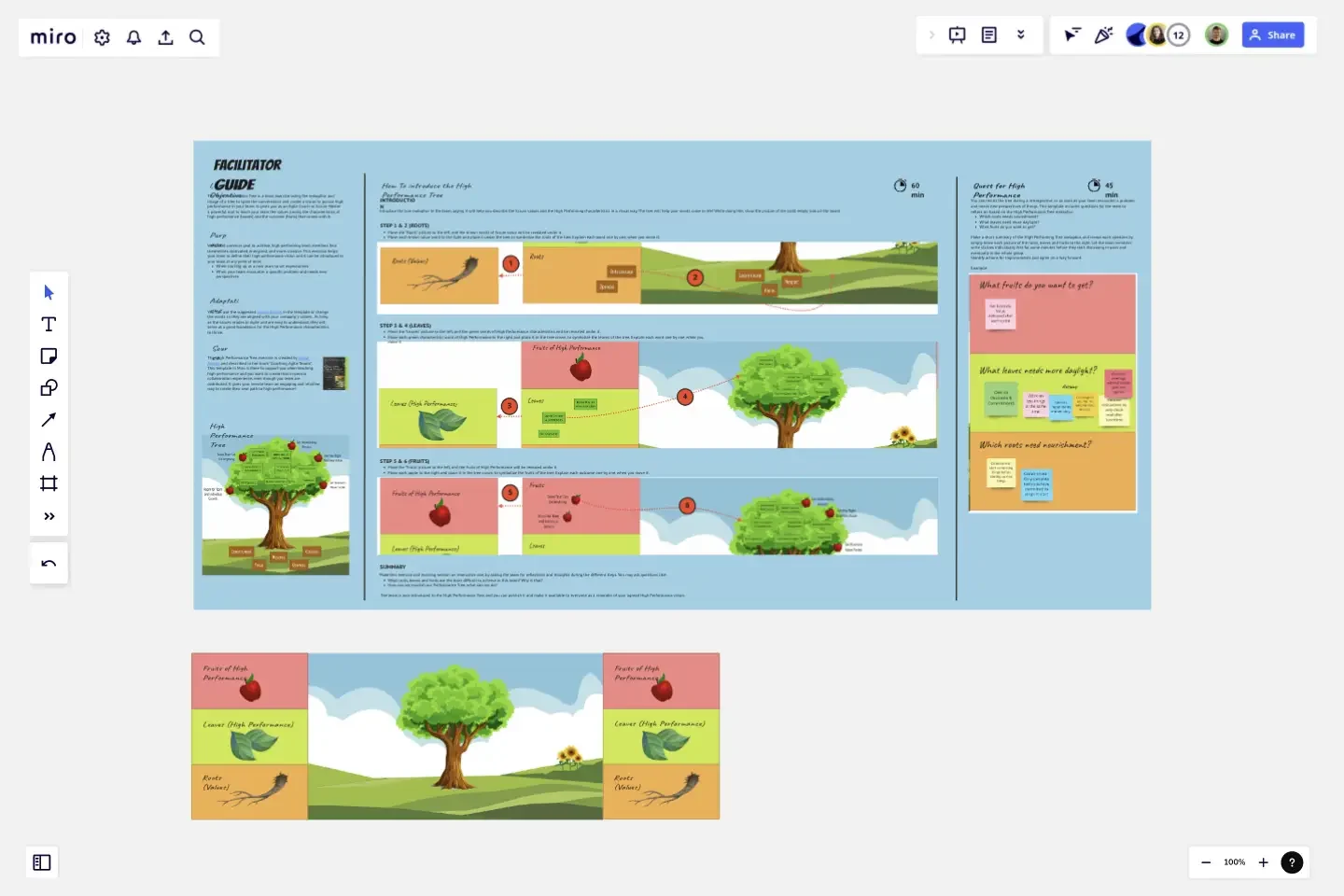Team´s High Performance Tree
The High Performance Tree is a team exercise using the metaphor and image of a tree, to spark the conversation and create a vision to pursue high performance in your team.
Learning Objective
The High Performance Tree gives you as an Agile Coach or Scrum Master a powerful tool to teach your team the values (roots), the characteristics of high performance (leaves) and the outcome (fruits) that comes with it.
Purpose
With a set common goal to achieve, high-performing team members find themselves motivated, energized, and more creative. This exercise helps your team to define their high performance vision and it can be introduced to your team at any point of time;
When starting up as a new team to set expectations
When your team encounter a specific problem and needs new perspectives
Adaptions
You can use the suggested Scrum Values in the template or change the words so they are aligned with your company ́s values. As long as the values relates to Agile and are easy to understand, they will serve as a good foundation for the High Performance characteristics to thrive.
Source
The High Performance Tree exercise is created by Lyssa Adkins and described in her book “Coaching Agile Teams”. This template in Miro is there to support you when teaching high performance and you want to create that in-person collaboration experience, even though you team are distributed. It gives your remote team an engaging and intuitive way to create their own path to high performance!
This template was created by Johanna Torstensson.
Get started with this template right now.
Roadmap Planning Template
Works best for:
Roadmap, Agile
The Roadmap Planning Template in Miro is a dynamic tool designed to streamline the process of planning and tracking project milestones. This template is part of Miro's Intelligent Templates offering, which integrates AI, interactive widgets, and automation to enhance productivity. One key feature of this template is its real-time collaboration capability, allowing team members to work together seamlessly, regardless of their location. This feature ensures that everyone is on the same page, making it easier to assign tasks, set deadlines, and track progress effectively.
Sprint Planning with Jira Template
Works best for:
Sprint Planning, Agile
The Sprint Planning with Jira template in Miro is a powerful tool designed to streamline and enhance your sprint planning sessions. One of the key benefits of this template is its Jira integration, which saves time and effort when planning and aligning teams. By integrating directly with Jira, the template allows for seamless import and management of tasks, ensuring that all your Jira tickets are up-to-date and easily accessible within Miro. This reduces the need for manual updates and minimizes errors, making the planning process more efficient and effective.
Easter Egg Retrospective
Works best for:
Agile Methodology, Retrospectives, Meetings
The Easter Egg Retrospective template offers a themed approach to retrospectives, incorporating elements of the Easter holiday. It provides elements for reflecting on past iterations, hunting for hidden insights, and brainstorming improvements. This template enables teams to have fun while addressing serious topics, fostering creativity and collaboration. By promoting a playful yet productive atmosphere, the Easter Egg Retrospective empowers teams to uncover hidden gems, drive improvement, and strengthen team cohesion effectively.
Feature Planning Template
Works best for:
Desk Research, Agile Methodology, Product Management
Features are what make a product or service fun, but adding new ones is no walk in the park. It takes many steps—ideating, designing, refining, building, testing, launching, and promoting—and just as many stakeholders. Feature Planning lets you put a smooth, sturdy process in place, so you can add a feature successfully, and spend less time and resources doing it. That makes our Feature Planning Template a smart starting point for anyone looking to add new product features, especially members of product, engineering, marketing, and sales teams.
Scrum Puzzle
Works best for:
Agile
The Scrum Puzzle is a collaborative activity that reinforces Scrum roles, artifacts, and ceremonies. By assembling a puzzle representing the Scrum framework, teams gain a deeper understanding of its components and how they interrelate. This template offers a fun and interactive way to reinforce Scrum knowledge and promote team alignment, empowering practitioners to apply Scrum principles effectively and deliver value with agility.
Lean Procurement Canvas
Works best for:
Agile
The Lean Procurement Canvas is a visual tool for optimizing procurement processes by applying Lean principles. It provides a structured framework for defining customer needs, identifying waste, and streamlining procurement activities. This template enables procurement teams to visualize their processes, identify improvement opportunities, and enhance efficiency and effectiveness. By promoting transparency and collaboration, the Lean Procurement Canvas empowers organizations to deliver value through optimized procurement practices.
